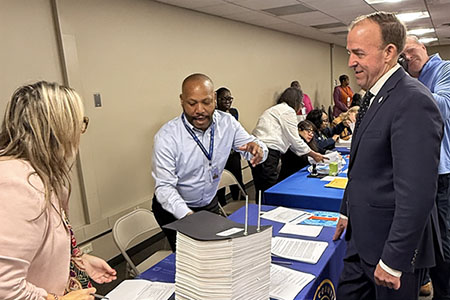Jun. 29, 2019 – President Donald Trump’s trade war with China is having a positive effect on the United States housing market, experts say.
Home-loan interest rates continued to plummet in late June to the lowest level since November 2016, reports Freddie Mac’s Primary Mortgage Market Survey. On June 27, benchmark 30-year fixed mortgages averaged 3.73 percent nationwide, down from 3.84 percent a week earlier.
It was the seventh time in the last nine weeks that rates moved lower. Freddie Mac reported interest charges hit the lowest level since November 2016 when 30-year fixed mortgage rates averaged 3.54 percent. Last year at this time, the 30-year fixed loans averaged 4.55 percent.

|
On June 27, 15-year fixed mortgages averaged 3.16 percent, down from 3.25 percent a week earlier. In early November 2016, 15-year fixed loans averaged 2.84 percent. Last year at this time, they averaged 4.04 percent.
|
Thirty-year fixed home loan rates in the Chicago area on June 27 ranged from 3.731 to 3.94 percent, reported RateSeeker.
Meanwhile, investors reacted by driving the 10-year Treasury yield to 2.0 percent, its lowest point in weeks.
Economists say a confidence-shaking trade battle between the U.S. and China – and a slowdown in economic growth – played a major role in the recent decline in mortgage interest rates.
|
“Trump’s trade war with China is sapping confidence,” said Paul Ashworth (right), chief U.S. economist at Capital Economics.
Trump, who is counting on a strong economy as he campaigns for reelection next year, has pushed the Federal Reserve to immediately start cutting interest rates to undo what he sees as the damage from four unnecessary Fed rate hikes last year.
|

|
At its most recent meeting, the Fed did signal that it was prepared to cut its federal funds rate if needed to protect the economy from a growing trade dispute between the U.S. and China. The funds rate currently is pegged at 2.25 to 2.5 percent.
The immediate result of a Fed rate cut could mean a 0.25 percent decrease in home-loan rates, experts say.

|
“While the industrial and trade-related economic data continues to dominate the news, the drop in mortgage rates over the last two months is already being felt in the housing market,” noted Sam Khater (left), Freddie Mac’s chief economist.
|
“Through late June, home purchase applications improved by five percentage points compared with the previous month. In the near term, we expect the housing market to continue to improve from both a sales and price perspective,” said Khater.
So, what do all these numbers mean to prospective house hunters and homeowners seeking to refinance? The window of opportunity for locking in a near record-low mortgage rate this summer is wide open.
|
Mortgage rate history
Mortgage rates hit a historical rock bottom on November 21, 2012, when the 30-year fixed mortgage average hit 3.31 percent, Freddie Mac reported. Nearly 20 years ago, in August 1999, when many of today’s Millennial borrowers were in grammar school, lenders were quoting 8.15 percent on a 30-year fixed mortgage.
However, to really appreciate today’s historically low interest rates, housing experts say home buyers need only to look at what banks and mortgage lenders where charging more than three decades ago in the early 1980s.
According to Freddie Mac, benchmark 30-year mortgage rates peaked at a whopping 18.45 percent in October 1981 during the Great Recession of the 1980s. Rates fell below 10 percent in April 1986, then bounced in the 9-to-10 percent range during the balance of the 1980s.
Archives of the now-defunct Federal Housing Finance Board show long-term mortgage rates were relatively affordable five decades ago at 5.81 to 5.94 percent between 1963 and 1965.
In 1966 and 1967, borrowers paid an average of 6.3 to 6.4 percent. In the 1960s, rates last dipped below 6.5 percent in January 1968, when the national average hit 6.41 percent. Between 1971 and 1977, the now-defunct Illinois Usury Law held rates in the 7.6-to-9 percent range.
|

















